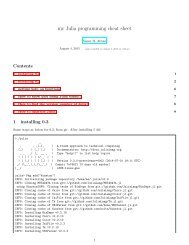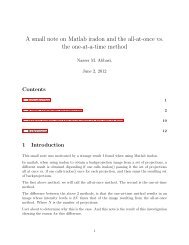You also want an ePaper? Increase the reach of your titles
YUMPU automatically turns print PDFs into web optimized ePapers that Google loves.
18.7.2 Bi-Elliptic transfer orbit . . . . . . . . . . . . . . . . . . . . . . . . . . . . . . . . . . . . . 74<br />
18.7.3 semi-tangential elliptical transfer . . . . . . . . . . . . . . . . . . . . . . . . . . . . . . . . 75<br />
18.8 Rocket engines, Hohmann transfer, plane change at equator . . . . . . . . . . . . . . . . . . . . . 75<br />
18.8.1 Rocket equation with plane change not at equator . . . . . . . . . . . . . . . . . . . . . . 77<br />
18.9 Spherical coordinates . . . . . . . . . . . . . . . . . . . . . . . . . . . . . . . . . . . . . . . . . . . 78<br />
18.10interplanetary transfer orbits . . . . . . . . . . . . . . . . . . . . . . . . . . . . . . . . . . . . . . 79<br />
18.10.1 interplanetary hohmann transfer orbit, case one . . . . . . . . . . . . . . . . . . . . . . . . 79<br />
18.11rendezvous orbits . . . . . . . . . . . . . . . . . . . . . . . . . . . . . . . . . . . . . . . . . . . . . 81<br />
18.11.1 Two satellite, walking rendezvous using Hohmann transfer . . . . . . . . . . . . . . . . . . 81<br />
18.11.2 Two satellite, separate orbits, rendezvous using Hohmann transfer, coplaner . . . . . . . . 83<br />
18.11.3 Two satellite, separate orbits, rendezvous using bi-elliptic transfer, coplaner . . . . . . . . 85<br />
18.12Semi-tangential transfers, elliptical, parabolic and hyperbolic . . . . . . . . . . . . . . . . . . . . 88<br />
18.13Lagrange points . . . . . . . . . . . . . . . . . . . . . . . . . . . . . . . . . . . . . . . . . . . . . . 90<br />
18.14Orbit changing by low contiuous thrust . . . . . . . . . . . . . . . . . . . . . . . . . . . . . . . . 91<br />
18.15References . . . . . . . . . . . . . . . . . . . . . . . . . . . . . . . . . . . . . . . . . . . . . . . . . 91<br />
19 Dynamic of flights 92<br />
19.1 Wing geometry . . . . . . . . . . . . . . . . . . . . . . . . . . . . . . . . . . . . . . . . . . . . . . 92<br />
19.2 Summary of main equations . . . . . . . . . . . . . . . . . . . . . . . . . . . . . . . . . . . . . . . 94<br />
19.2.1 Writing the equations in linear form . . . . . . . . . . . . . . . . . . . . . . . . . . . . . . 96<br />
19.3 definitions . . . . . . . . . . . . . . . . . . . . . . . . . . . . . . . . . . . . . . . . . . . . . . . . . 98<br />
19.4 images and plots collected . . . . . . . . . . . . . . . . . . . . . . . . . . . . . . . . . . . . . . . . 100<br />
19.5 Some strange shaped airplanes . . . . . . . . . . . . . . . . . . . . . . . . . . . . . . . . . . . . . 117<br />
19.6 links . . . . . . . . . . . . . . . . . . . . . . . . . . . . . . . . . . . . . . . . . . . . . . . . . . . . 119<br />
19.7 references . . . . . . . . . . . . . . . . . . . . . . . . . . . . . . . . . . . . . . . . . . . . . . . . . 119<br />
1 Modal analysis for two degrees of freedom system<br />
Detailed steps to perform modal analysis are given below for a standard undamped two degrees of freedom<br />
system. The main advantage of solving a multidegree system using modal analysis is that it decouples the<br />
equations of motion (assuming they are coupled) making solving them much simpler.<br />
In addition it shows the fundamental shapes that the system can vibrate in, which gives more insight into<br />
the system. Starting with standard 2 degrees of freedom system<br />
x 1<br />
x 2<br />
k 1 k 2<br />
m 1 m 2<br />
f 1 t<br />
f 2 t<br />
In the above the generalized coordinates are x 1 and x 2 . Hence the system requires two equations of motion<br />
(EOM’s).<br />
1.1 Step one, finding the equations of motion in normal coordinates space<br />
The two EOM’s are found using any method such as Newton’s method or Lagrangian method. Using Newton’s<br />
method, free body diagram is made of each mass and then F = ma is written for each mass resulting in the<br />
equations of motion. In the following it is assumed that both masses are moving in the positive direction and<br />
that x 2 is larger than x 1 when these equations of equilibrium are written<br />
3





